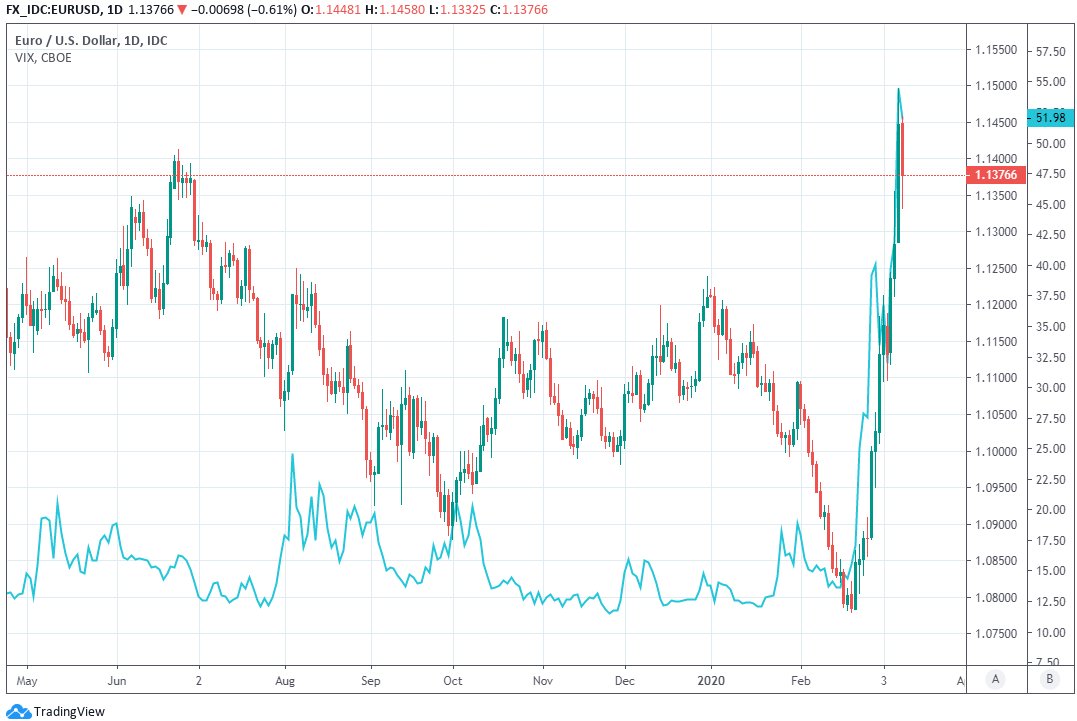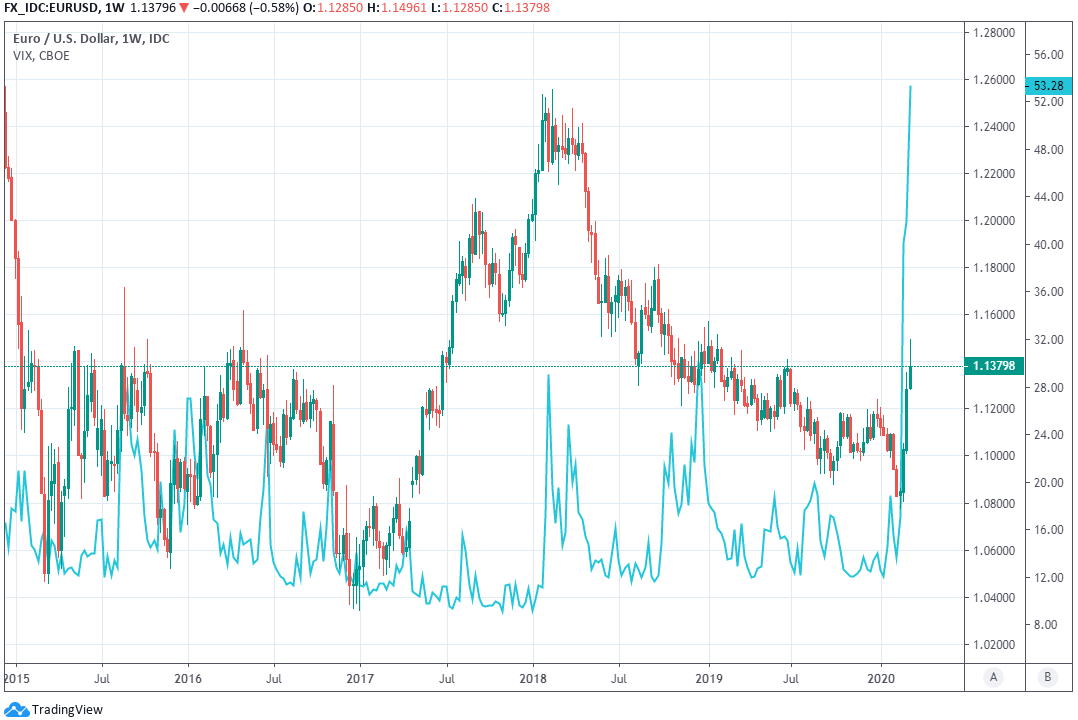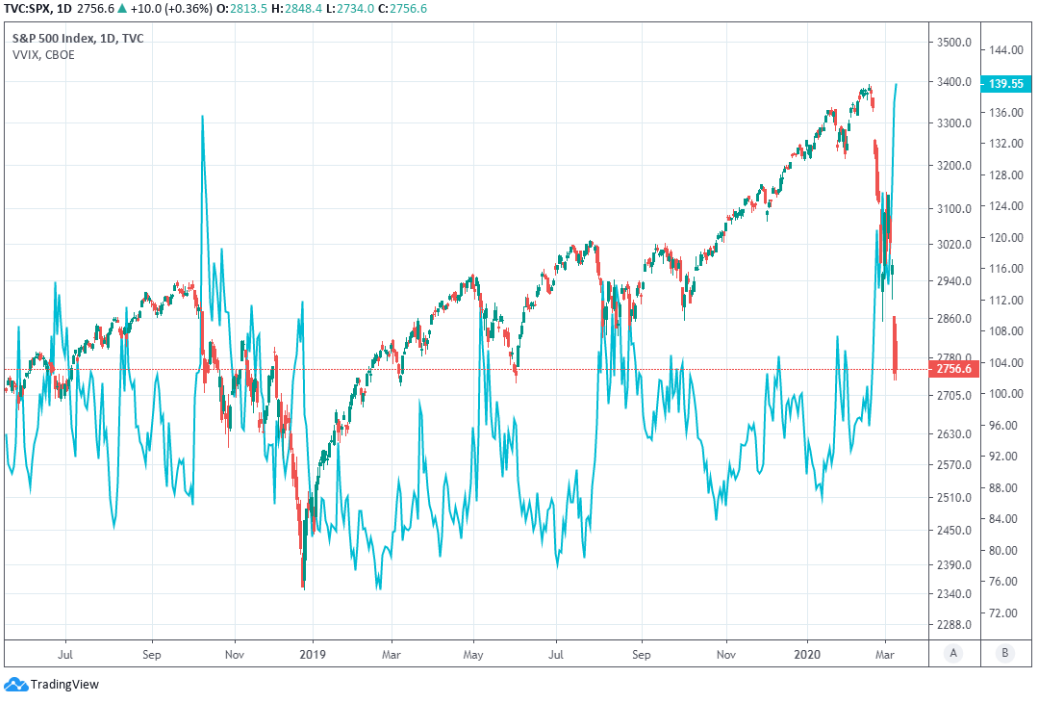The Euro-to-Dollar Rate: Forecasts Upgraded at Nordea Markets as USD Hedging to Increase
- Written by: James Skinner
-
- EUR down on ceasefire in risk sell-off but forecasts upgraded.
- Nordea raises year-end target, looks for more EUR/USD gains.
- After Fed rate cut slashes FX hedging costs for USD investors.
- Effect of stock market wash out amplified by lack of FX hedges.
- Says with U.S. rates at 1.25%, investors may resume hedging.
- Ensuring steady bid lifts EUR/USD to 1.17 in time for year-end.

Image © Adobe Images
- EUR/USD Spot rate: 1.1381, down -0.17% today
- Indicative bank rates for transfers: 1.0916-1.0995
- Transfer specialist indicative rates: 1.1142-1.1210 >> Find Out More About This Rate
The Euro-to-Dollar rate softened Tuesday as calm returned to markets ahead of an anticipated stimulus announcement from the U.S. although forecasts for the exchange rate have been upgraded by strategists at Nordea Markets, who see the single currency as a likely beneficiary of a reduction of Dollar hedging costs.
Europe’s unified unit retreated back below the 1.14 handle Thursday as oil prices caught a corrective bid and bonds were sold in the wake of Monday’s punishing losses, which had incited the Euro into a challenge of the 1.15 level. Euro declines came as Italians spent their first day under a nationwide ‘lockdown’ in which travel is heavily restricted in order to prevent the spread of coronavirus, reflecting a government decision that’s likely to deal the economy a severe blow in the first and second quarters.
And investors now have to face the possibility of such measures being implemented in other major economies and also, potentially in the U.S., although calm has returned to financial markets and the Euro is in retreat ahead of an announcement from President Donald Trump. That’s expected to yield a “very substantial relief” for companies and households as they brace for a possible increase in coronavirus cases after four million test kits were delivered to states on Monday, eliminating an earlier shortage.
“The size and rapidity of the current market moves risk making any forecast obsolete in minutes, so one needs to be quite humble in making such calls. Still, it looks increasingly unlikely that the pain and uncertainty felt by financial markets would quickly abate. It appears at least as likely that ever easier central bank policy will be needed to counter the risks facing the global economy,” warns Jan von Gerich, an economist at Nordea Markets.
Above: Euro-to-Dolalr rate shown at daily intervals alongside CBOE VIX index of imlied volatility for the S&P 500 index.
President Donald Trump said he wants to make sure Americans are “not going to miss a paycheck” as a result of the virus that’s disrupting business and could force many into self-isolation, with a number of industries expected to also be in line for some form of assistance. However, National Economic Council director Larry Kudlow told CNBC Tuesday that any decisions on “spending or taxes” would require congressional involvement and take time.
The UK government is also expected to include coronavirus-related support and stimulus in its 2020 budget on Wednesday while both the New Zealand and Australian governments are also expected to announce special measures. And Canada’s government will pick and run with the policy ball next week with what is mooted to be a substantial program of support in its own year-ahead budget.
G7 governments are offering a comfort blanket to markets barely a week after the Federal Reserve and Bank of Canada announced their largest interest rate cuts since the financial crisis, which has taken some of the wind out of the Euro’s sails after a 6.5% increase driven by risk aversion over the 13 trading days heading into Tuesday.
The European Central Bank is expected to announce its own policy response on Thursday, which is a risk to the single currency although Nordea says the nascent weakness in the Euro-to-Dollar rate is unlikely to last for long.
“The big move higher in EUR/USD, which we have seen in recent days, is probably mainly driven by position squaring and it may therefore have further legs to go, should equities continue to underperform, which looks kind of likely right now,” says Andreas Steno Larsen, an FX strategist at Nordea.
Above: Euro-to-Dolalr rate shown at weekly intervals alongside CBOE VIX index of imlied volatility for the S&P 500 index.
“Most European asset managers have had a big long USD position via a low hedge ratio on USD assets. If US equities are sold off then we see a net selling of USD spot due to a low or non-existent hedge of the USD component, that’s the position squaring part. The next move could be driven by increased USD hedge ratios, as FX hedge costs are falling off a cliff,” Larsen says.
Many had borrowed Euros to fund bets on more attractive assets elsewhere in recent years, which is why the Euro rose as stock markets and developing world currencies began to fall apart again in mid-February. Investors were forced to buy back Euros they’d previously sold, generating the increase in the Euro-to-Dollar rate although the upward move was exacerbated by the fact that many had long stopped hedging Dollar exposure when investing in the U.S.
Investors who bought the EUR/USD rate before the Fed’s 50 basis point rate cut last week will have had to pay the interest rate differential between the two currencies, which was nearly 2% at the central bank benchmark level but is now closer to 1% and likely to fall even further if the Fed cuts rates again later this month. And the requirement to pay that differential had led some fund managers to stop hedging their U.S investments, which would have involved them buying the EUR/USD forward rate at the same time as buying a U.S. bond or stock.
An absence of hedges meant that when investors sold U.S. stocks and bonds last week they did so without selling EUR/USD in order to close out hedges they may otherwise have had, amplifying the Euro's upward move. Returns from those under-hedged or unhedged trades will have been at risk for Europe-based investors as the Euro-to-Dollar rate rose through February and could be threatened again by incremental bouts of strength up ahead, which is partly why Larsen says investors might now lift hedge ratios.
Above: S&P 500 stock index shown at weekly intervals alongside CBOE VIX index of imlied volatility for the S&P 500 index.
Higher hedge ratios would weigh on the greenback and lift the Euro-to-Dollar rate, which is widely expected to continue to benefit from bouts of risk aversion in the broader financial markets, likely rising alongside the Japanese Yen as riskier prospects like the Pound and Aussie decline.
And with ECB interest rates already at zero or below, many analysts including Larsen doubt it will be able to conjour upat Thursday's meeting a policy response that's sufficient enough to offset the Fed's rate cuts. In other words, many doubt it can neutralise the Euro's newfound strength.
“It may prove very difficult for other central banks to compete in such a rapid race to the bottom, especially since several G10 central banks will have to compete from a starting point in the cellar. USD hedge costs have hence already fallen off a cliff, but more is likely in store soon,” Larsen says. “It simply becomes much more opportune for FX managers to increase hedge ratios in USD, when the price drops as fast as now. We choose to increase our EUR/USD target for year-end 2020 to 1.17 as a consequence.”
Larsen says that with the Fed likely to cut its interest rate further up ahead, those hedging costs will become even less prohibitive over the coming months no matter what the ECB does on Thursday in order to try to keep up with its U.S. counterpart. This could lead to a steady bid returning to the market for the Euro-to-Dollar rate as investors again seek to protect themselves from a possible fall in the value of the greenback during their investment.
Nordea upgraded its three-month Euro-to-Dollar rate forecast from 1.06 to 1.15 on Tuesday and lifted its end of 2020 forecast from 1.10 to 1.17.













